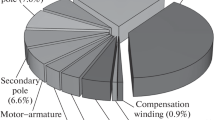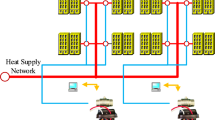Abstract
This study was aimed to figure out the effect on electrical characteristics of DC motor according to the brush surface states related to surface roughness and the other purpose was the effect of brush surface corrosion, which was formed by the accelerated testing based on Arrhenius-Peck model, on electrical contact. In order to investigate the relationship with the electrical contact according to the brush type, the brush-commutator of the DC motor applied to the actuator of passenger vehicles and the brush-commutator applied to the commercial vehicles actuator were evaluated together, and named with type A and type B, each. The higher surface roughness was, the better the circuit was energized, and type A brushes were more sensitive to the surface roughness. In terms with corrosion, contact resistance tended to be proportional to the test cycle for both types of brushes, and measured values of the contact resistance for type B brushes were higher than type A.











Similar content being viewed by others
Data availability
The datasets used and/or analysed during the current study available from the corresponding author on reasonable request.
Abbreviations
- a :
-
Brush insertion distance, mm
- ω :
-
Rotating angle of a bolt, degree
- d :
-
Effective diameter, mm
- l :
-
Lead dimension of a bolt, mm
- R o :
-
Contact resistance of the DC mortor, Ω
- I :
-
Current measured through shunt resistance, A
- V in :
-
Applied voltage by the power supply, V
- V measured :
-
Measured voltage between c and d of Figure 4, V
- V d :
-
Voltage drop, V
- AF :
-
Acceleration factor
- RH n :
-
General humidity condition, %RH
- RH a :
-
Accelerated humidity condition, %RH
- E a :
-
Average conservative activation energy, eV
- k :
-
Boltsmann’s constant, eV/K
- T n :
-
General temperature condition, °C
- T a :
-
Accelerated temperature condition, °C
- t test :
-
Test duration of HAST, hour
- CL :
-
Confidence level, %
- R T :
-
Test reliability, %
- N :
-
Sample size
- β :
-
Shape parameter of the Weibull distribution
- t use :
-
Total time exposed to the user environment, hour
- R a :
-
Roughness expressed with an arithmetic mean height, μm
- l e :
-
Evaluation length, mm
- x :
-
Horizontal component of a surface to be measured, mm
- z(x) :
-
Height of the assessed scale-limited profile, μm
- j :
-
Current density, A/mm2
- N br :
-
Number of brushes
- S :
-
Area of brush surface (width × height), mm2
- A and k :
-
Model parameters obtained through the nonlinear regression
References
Budynas, R. G., & Nisbett, J. K. (2011). Shigley’s mechanical engineering design (9th ed.). McGraw-Hill.
Duffy, O. C. and Wright, G. (2015). Fundamentals of Medium/Heavy Duty Commercial Vehicle Systems (2nd edn). Jones & Bartlett Learning. Burlington, Massachusetts, USA.
Fakih, B., & Dienwiebel, M. (2015). The structure of tribolayers at the commutator and brush interface: A case study of failed and non-failed DC motors. Tribology Int., 92, 21–28.
General Motors (GM) (2018). General Specification for Electrical/Electronic Components – Environmental/ Durability. GMW3172.
Gunn, J. E., Malik, S. K. and Mazumdar, P. M. (1981). Highly accelerated temperature and humidity stress test technique (HAST). 19th Int. Reliability Physics Symp., Orlando, Florida.
Hamilton, R. J. (2000). DC motor brush life. IEEE Transaction of Industry Applications, 36(6), 1682–1687.
Hinkle, D. E., Wiersma, W. and Jurs, S. G. (2003). Applied Statistics for the Behavioral Sciences (5th edn). Houghton Mifflin. Boston, Massachusetts, USA.
Hu, Z. L., Chen, Z. H., & Xia, J. T. (2008a). Study on surface film in the wear of electrographite brushes against copper commutators for variable current and humidity. Wear, 264(1–2), 11–17.
Hu, Z. L., Chen, Z. H., Xia, J. T., & Ding, G. Y. (2008b). Effect of PV factor on the wear of carbon brushes for micromotors. Wear, 265(3–4), 336–340.
Hughes, A., & Drury, B. (2019). Electric motors and drives: Fundamentals, types and applications (5th ed.). Newnes.
ISO 16750-1 (2018). Road Vehicles — Environmental Conditions and Testing for Electrical and Electronic Equipment — Part 1: General (3rd edn). International Organization for Standardization (ISO).
ISO 724. (1993). ISO General-purpose Metric Screw Threads—Basic Dimensions (2nd edn). International Organization for Standardization (ISO).
ISO 68-1 (1998). ISO General Purpose Screw Threads — Basic Profile — Part 1: Metric Screw Threads (1st edn). International Organization for Standardization (ISO).
ISO 21920-2 (2021). Geometrical Product Specifications (GPS) — Surface Texture: Profile — Part 2: Terms, Definitions and Surface Texture Parameters (1st edn). International Organization for Standardization (ISO).
ISO21920-3 (2021). Geometrical Product Specifications (GPS) — Surface Texture: Profile — Part 3: Specification Operators (1st edn). International Organization for Standardization (ISO).
Lee, J., & Yun, S. (2023). Development of the fatigue life model for plastic gears of automotive actuators under vibration. Engineering Failure Analysis, 144, 106992.
Ogura, T., Sugiyama, T., & Sugiura, N. (2020). Estimation of the shape parameter of a wear-out failure period for a three-parameter weibull distribution in a small sample. International Journal of Statistics and Probability, 9(6), 39–48.
Okada, A., & Toda, M. (1982). Influence of silicone contamination on brush-commutator contacts in small- size DC motors. IEEE Transaction of Components, Hybrids, and Manufacturing Technology, 5(2), 281–286.
Peck, D. S. (1986). Comprehensive model for humidity testing correlation. 24th Int. Reliability Physics Symp., Anaheim, California, USA.
Seber, G. A. F., & Wild, C. J. (2003). Nonlinear regression. John Wiley & Sons.
Shin, W. G., & Lee, S. H. (2010). An analysis of the main factors on the wear of brushes for automotive small brush-type DC motor. Journal of Mechanical Science and Technology, 24, 37–41.
Shin, W. G., Lee, S. H., & Song, Y. S. (2006). Development of an accelerated life test procedure for cooling fan motors. International Journal of Automotive Technology, 7(6), 757–762.
Turel, A., Slavič, J., & Boltežar, M. (2017). Electrical contact resistance and wear of a dynamically excited metal–graphite brush. Advances in Mechanical Engineering, 9(3), 1687814017694801.
Volkswagen (2017). Electric and Electronic Components in Motor Vehicles up to 3.5 t. VW 80000.
Yasar, I., Canakci, A., & Arslan, F. (2007). The effect of brush spring pressure on the wear behaviour of copper–graphite brushes with electrical current. Tribology International, 40(9), 1381–1386.
Acknowledgements
This work supported by Korean Institute for Advancement of Technology (KIAT) grant funded by Ministry of Trade, Industry and Energy (Material-component fusion alliance (machine/automobile field)), Korea.
Author information
Authors and Affiliations
Corresponding author
Additional information
Publisher's Note
Springer Nature remains neutral with regard to jurisdictional claims in published maps and institutional affiliations.
Rights and permissions
Springer Nature or its licensor (e.g. a society or other partner) holds exclusive rights to this article under a publishing agreement with the author(s) or other rightsholder(s); author self-archiving of the accepted manuscript version of this article is solely governed by the terms of such publishing agreement and applicable law.
About this article
Cite this article
Lee, J., Yun, S. Experimental Study on the Electrical Performance of an Automotive Actuator DC Motor According to Brush Surface States. Int.J Automot. Technol. 25, 13–21 (2024). https://doi.org/10.1007/s12239-024-00002-0
Received:
Revised:
Accepted:
Published:
Issue Date:
DOI: https://doi.org/10.1007/s12239-024-00002-0




